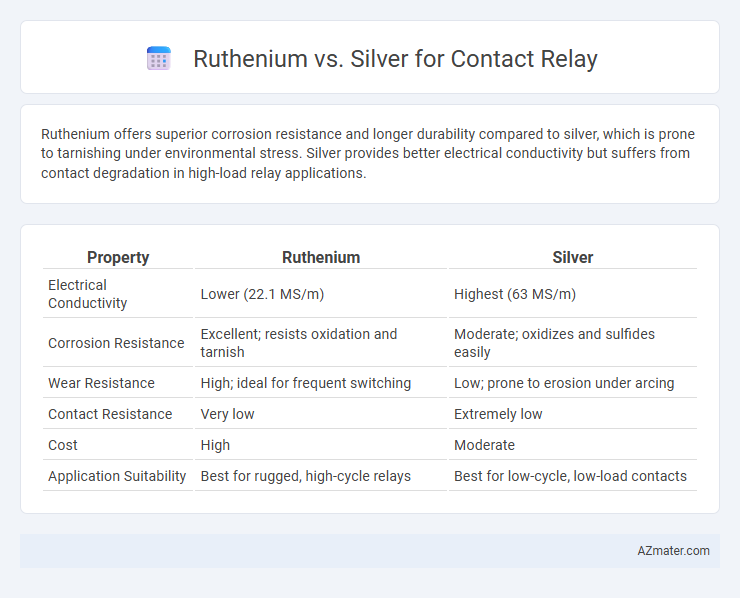Ruthenium offers superior corrosion resistance and longer durability compared to silver, which is prone to tarnishing under environmental stress. Silver provides better electrical conductivity but suffers from contact degradation in high-load relay applications.
Table of Comparison
| Property | Ruthenium | Silver |
|---|---|---|
| Electrical Conductivity | Lower (22.1 MS/m) | Highest (63 MS/m) |
| Corrosion Resistance | Excellent; resists oxidation and tarnish | Moderate; oxidizes and sulfides easily |
| Wear Resistance | High; ideal for frequent switching | Low; prone to erosion under arcing |
| Contact Resistance | Very low | Extremely low |
| Cost | High | Moderate |
| Application Suitability | Best for rugged, high-cycle relays | Best for low-cycle, low-load contacts |
Introduction to Contact Relays: Ruthenium vs Silver
Contact relays rely on materials that ensure reliable conductivity and resistance to wear; ruthenium and silver are key contenders in this field. Ruthenium offers superior corrosion resistance and enhanced durability under high electrical loads compared to silver, which excels in conductivity but can tarnish and wear faster. Choosing ruthenium or silver for contact relays impacts performance, longevity, and maintenance frequency in electrical systems.
Material Properties of Ruthenium and Silver
Ruthenium exhibits superior corrosion resistance and hardness compared to silver, making it highly durable for contact relay applications where longevity and reliability under harsh conditions are essential. Silver offers excellent electrical conductivity but is prone to tarnishing and contact degradation over time, which can impair relay performance. Ruthenium's high melting point and wear resistance contribute to enhanced contact stability and reduced maintenance in high-load switching environments.
Electrical Conductivity Comparison
Ruthenium exhibits lower electrical conductivity compared to silver, with silver achieving approximately 63 x 10^6 S/m while ruthenium is around 14 x 10^6 S/m. Despite silver's superior conductivity, ruthenium offers enhanced corrosion resistance and stability, making it advantageous in relay contacts subject to harsh environments. The trade-off between ruthenium's durability and silver's conductivity influences material selection based on specific relay performance requirements.
Contact Resistance and Performance
Ruthenium contacts exhibit significantly lower contact resistance compared to silver, enhancing conductivity and reducing energy loss in relay applications. Ruthenium's superior performance is attributed to its excellent corrosion resistance and stability under high load conditions, which maintain consistent contact integrity over time. Silver, while highly conductive, tends to suffer from oxidation and surface degradation, leading to increased resistance and reduced relay reliability.
Durability and Lifespan in Relay Applications
Ruthenium contacts exhibit superior durability and longer lifespan compared to silver in relay applications due to their higher resistance to oxidation and electrical wear. Ruthenium's hardness and stable oxide layer minimize contact degradation, ensuring reliable performance under high current and harsh environments. Silver contacts, while offering excellent conductivity, tend to suffer from faster erosion and oxidation, leading to reduced operational lifespan and increased maintenance frequency.
Corrosion and Tarnish Resistance
Ruthenium offers superior corrosion and tarnish resistance compared to silver, making it ideal for contact relay applications where long-term reliability is crucial. While silver provides excellent electrical conductivity, it is prone to oxidation and tarnishing, which can degrade contact performance over time. Ruthenium's robust resistance to environmental factors ensures consistent conductivity and minimizes maintenance needs in harsh operating conditions.
Cost Analysis: Ruthenium vs Silver Contacts
Ruthenium contacts in relays generally offer higher cost efficiency over silver due to their superior durability and lower maintenance requirements, extending the lifecycle and reducing replacement expenses. Although silver has a lower initial material cost, it is prone to oxidation and contact wear, leading to increased downtime and operational costs in high-load or harsh environments. Cost analysis favors ruthenium for long-term applications where reliability and reduced service intervals translate into significant total cost savings despite the higher upfront price.
Suitability for High-Load and Low-Load Relays
Ruthenium offers superior performance for high-load relays due to its excellent resistance to arc erosion and high melting point, ensuring durability under heavy electrical stress. Silver, while highly conductive and effective in low-load relays, tends to degrade faster under high-load conditions because of its lower resistance to oxidation and wear. For applications requiring longevity and reliability in demanding electrical environments, ruthenium-plated contacts are preferable, whereas silver contacts remain optimal for low-load, cost-sensitive relay designs.
Common Industrial Applications
Ruthenium contacts in relays provide superior corrosion resistance and lower contact resistance, making them ideal for industrial environments with high humidity and exposure to contaminants. Silver contacts offer excellent electrical conductivity and are cost-effective, preferred in applications requiring high current carrying capacity but less prone to corrosive conditions. Common industrial uses of ruthenium include automated manufacturing systems and precision instrumentation, while silver contacts are widespread in motor controls and power distribution relays.
Conclusion: Choosing the Optimal Material for Relay Contacts
Ruthenium offers superior corrosion resistance and lower contact resistance compared to silver, making it ideal for high-reliability relay contacts in demanding environments. Silver provides excellent electrical conductivity and cost-effectiveness but is more susceptible to oxidation and surface degradation over time. Selecting the optimal contact material depends on application-specific requirements, balancing durability and performance with budget constraints.

Infographic: Ruthenium vs Silver for Contact Relay
 azmater.com
azmater.com